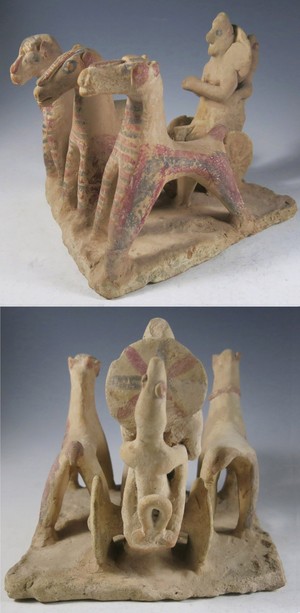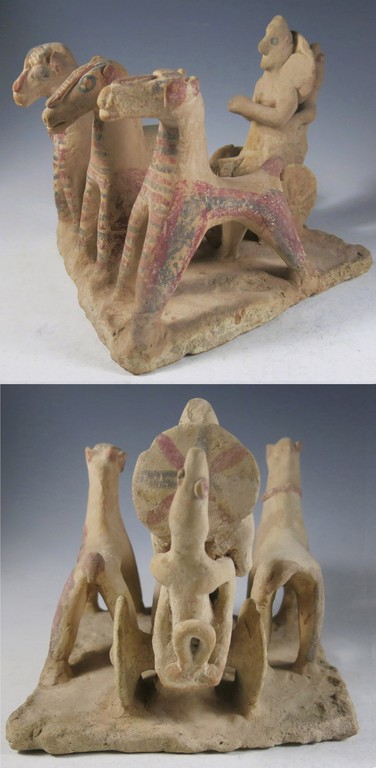Cypriot chariot model with horses: Archaic I (750-600 BC)
Model of Triga chariot (apparently). It is probable that although the chariot with its riders is genuine, as is each individual horse, they may have been put together in a group by a dealer from different sources (see below).
Many votive chariot models and warrior figures are known from the rural shrines (Temene) of the Cypriot Iron Age. They suggest a male god who may have been associated with fertility, perhaps with agrarian associations. They also suggest that Royal and elite symbols had been taken up more widely, perhaps as part of a prevalent cosmological symbolism.
Chariots are known from illustration on pottery and from wheel ruts in Kition from the Late Bronze Ag but became common in Cyprus from the 8th century BC, but Actual chariots have been found at Salamis, Kourion, Meniko and in the Limassol district. They were used for warfare in Cyprus as late as the 5th century BC, after their use had become purely ceremonial in Greece, as mentioned by Herodotus, and continued for ceremonial use for a while after. Their introduction may have been influenced by the Assyrians. Their abundant representations in the 7th - 6th centuries suggest chariots and cavalry were used in battle at the same time. The Cypriot chariots were unusual in often having two shafts, though the shafts and yokes are not always depicted in models. Here, though, there is only a socket for one. They are depicted with 1-4 riders (in this case 2). Model chariots have only been found in shrines and not in tombs and like the soldier models are presumed to have been left in the shrines of a male god as votive offerings.
Almost all models are of Quadrigas (with 4 horses) with only a very few Bigas (2 horses). Of those known to V Karageorghis none are Trigas (3 horses), as here, though he says they probably existed and certainly existed in other countries, though rare. I have seen another triga model from the Cyprus Museum, Carolina (recently dispersed), but in the past chariot models have been known to be faked by combining parts from more than one chariot model. The quantity of paint on this model is unusual - a number of them have lost their paint. The horses are usually crowded together but here are well spaced. There would have been room for 4 horses. Also the right hand horse has a different, more vertical and static stance than the others, and a collar modelled in relief with a tassel hanging down the front which the others do not. The middle horse is shorter than the others, perhaps to allow room for the chariot. Compared to other pottery chariot models with horses, the chariot is unusually small and narrow, given the width of the base plate, which is suspicious. it is much more like the few known chariot models created with riders but without horses. The lack of depicted shafts is unusual and 3 horses would surely have needed two shafts, yet the single socket suggests one shaft. There is cracking in the "clay" of the base.
The chariot with its riders is consistent with a known type, made without a base or horses, and with a socket for the undepicted shaft. (Art Antique de Chypre au Musée du Louvre. 1992A Caubet,A Hermary & V Karageorghis 1992 Athens p 112-3 Pl138,139). If so it is a particularly good example. The driver has a round shield on his back, painted with alternating red and black radiating lines, similar to those on the wheels. The second figure holds onto his waist from behind. The eyes and ears of both are painted in black. A loop rises from the back of the chariot, presumably to hold onto or prevent riders falling out. The horses are consistent with some horses in chariot models, with a pad along the brow and nose of each horse, though no bridles. They are less consistent with single horses or horses with riders. However the horse on the right has a different stance (legs more vertical) and is the only one with a modelled piece of harness around the neck with a tassel. This may suggest they are from different sources. Yet the elaborate paint in red and black on the horses, especially the multiple horizontal lines up the chests (perhaps suggesting a protective pad) and extensive paint on the sides of the middle horse and the outer sides of the outer horses, unifies the group. I need to check if this paint is original or added to bind them together visually. There is also paint on the horses' nose-pads, eyes, ears, and short tails. Shafts are not depicted, which are usual though not invariable, but the shaft socket on its own is not normally found on chariot models with horses but is normal for those without. To sum up, the individual horses and the chariot look genuine, but the question is, is this a genuine single model or is it made up of parts from two or more models, perhaps on on a modern base and with added paint? I believe the latter. I intend to have TL tests done.
Chariot (Archaic I)
Size: 17cm h x 19.5 x 22.5
(Ex collection of BL (friend, named in my records). Bought 1991 from dealer Chris Martin. (It was claimed Desmond Morris considered buying this model).)
(Aquired Private sale, December 2018 see above.)
DJ 125

